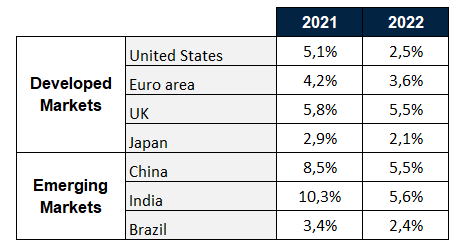2021: The year of growth. And then?
Global economic forecasts for 2021 point to a clear recovery. However, not all countries will grow at the same rate. As usual, China and India top the ranking of the fastest growing countries:

Fuente: Morgan Stanley, Bloomberg, Haver Analytics, IMF, Morgan Stanley Research forecasts
In any case, it would be naive to think that these growths are going to be maintained over time.
To try to understand what the world could be like after the COVID crisis, perhaps we could look at how it was before.
Low Rates, Low Growth, Low Inflation
These three points are have characterized developed economies from the 2008 crisis to the COVID crisis.
In fact, despite being the longest period of expansion in the history of the United States, it has also been the one with the slowest growth. Perhaps, it is a consequence of the liquidity trap to which the central banks were as well as high debt levels.
Will it continue to be so?
First of all, it looks like rates will remain low for a while. In fact, the FED pointed out that until 2023 they will not consider rate hikes. Also, economic growth will be high both this year 2021 and 2022.
Therefore, we might think that the context has changed for the part of economic growth rather than interest rate policy.
On the other hand, the big question we have is inflation. The increase in commodity price and the increase in demand are causing inflation to be high, especially in the United States.
The question that everyone is asking is whether this inflation will be momentary, as a consequence of the "base effects" of the covid, or if it will be a secular trend for the next few years. Digitization can have a moderating effect by increasing productivity.
Once the first post-covid years have passed, we could return to the previous world: rates close to zero, anemic inflation and moderate growth. Has the Covid-19 crisis been an event of such magnitude as to change the structural trends of the world economy?
